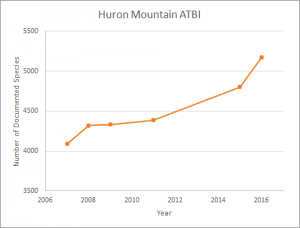[Warning: this is a longer-than-usual post. Biological diversity is something worth dwelling on…]
All-taxa Biodiversity Inventories (ATBIs) are efforts to fully document biological diversity — list all the species — for some defined area. The value of such documentation, in a world where all the indications are that we’re in the midst of catastrophic losses in biodiversity, may seem self-evident, yet there are surprisingly few such efforts.
The most famous and extensive ATBI is for Great Smoky Mountains National Park; it’s now approaching a total of 20,000 species across all taxonomic groups. The Smoky Mountain — and all other ATBIs — remain incomplete; in fact, completion is unlikely and not really the objective. It’s more about documenting baselines and motivating discovery, particularly in otherwise rarely addressed groups. At a global scale, there is really no realistic hope of cataloguing large portions of our biodiversity heritage before it is lost, so having even a few intensively document areas becomes all the more important. They can give us at least something to extrapolate from about the diversity of vast areas of habitat that will be lost before we know what’s there.
As early as 2005, I realized that there was a substantial trove of biodiversity documentation in the reports from several decades of HMWF-sponsored research, and, with the support of then Director of Research, David Gosling, began compiling a ‘master list’ of species for the Huron Mts. That list ‘went live’ in 2007 as the fifth occasional paper of the Huron Mt. Wildlife Foundation. It’s published on-line only; as are all ATBIs, it’s a work in progress, and this allows regular updates as, with the assistance of many researchers, I integrate new reports and update taxonomy.

Total species count from the Huron Mountain ATBI, 2007-2016. Each point on the graph represents a published version of the document.
I posted the latest version last month. As predicted in a previous post, this version takes the total well past the 5000-species mark. The current total of 5175 amounts to more than a 25% increase just since 2007, or an average addition of 120 species/year. The rate is not slowing down (see graph). The largest block of new listings comes in the Lepidoptera (moths and butterflies), where about 500 new species have been found (so far) by two ongoing projects (conducted by Thomas Werner and James Bess), but this latest update also includes significant additions among other insect groups and fungi (especially endophytic fungi studied by Elizabeth Arnold).
Here is the break-down by major taxonomic groups:
Cyanobacteria (‘blue-green algae’): 25
Miscellaneous taxa of ‘algae’: 198
Bryophytes (mosses and liverworts): 370
Vascular plants: 834
Lichens: 326
Fungi: 879
Insects: 1955
all other Invertebrates: 212
Vertebrates: 376
We don’t expect to add much to the vertebrate list(maybe a few range expansions, vagrant birds, etc.), the vascular plants (a few introduced species), or bryophytes (because of the amazingly thorough work of Dr. William Manierre). Some groups of insects are probably pretty complete (like the dragonflies and damselflies), but all other groups are certainly significantly underdocumented. 2016 projects will add yet more insects, zooplankton (virtually undocumented so far), and a variety of micro-organisms. We have yet to ‘officially’ record any spiders, and there are certainly hundreds or thousands of species of mites, algae, bacteria…
Is this a lot? It’s hard to say for sure, but there are good reasons to suspect that Huron Mountain is an unusually diverse area. To put the numbers in perspective: Great Smoky Mountains National Park is more than 20 times the area of the Huron Mountain Club, is quite a bit further south (diversity tends to increase rapidly with decreasing latitude), and is generally recognized as having huge diversity of habitat, and yet Huron Mt. diversity is not, in many groups dramatically lower. The Smokies host 1700 species of vascular plants, compared to 834 at Huron Mt. For vertebrates, it’s 480 to 376; for dragonflies and damsel flies, it’s 94 to 81.
A massive compilation and meta-analysis of floristic data by Michael Palmer at Oklahoma State (the ‘Floras of North America Project‘) suggests that, given its size and latitude, the lands of the Huron Mt. Club ‘should’ host perhaps 300-400 species of vascular plants. Over 800 are known. Only 1/8 of these are non-indigenous, naturalized species.
Taken together, this all suggests that the area documented by the Huron Mt. ATBI is unusually diverse — legitimately ‘hyperdiverse’ for its latitude and size. Why might that be? I suspect several factors are at play. Certainly, the unusually high habitat diversity of the area — from granite balds to sandy barrens, to rich forests, to a wide range of wetlands and aquatic habitats — plays a role. But I suspect that the preservation of large tracts of pristine habitats is an even larger factor. Intensive human management tends to homogenize landscapes; uniformity of habitat translates to a less ‘room’ for species with different ecological requirements. Most of the forested landscape of the upper Great Lakes was heavily logged over the last 150 years, and even-aged, young(ish) forests are much more uniform than old-growth forest landscapes, where a much wider array of herbaceous plants, insect, birds, etc. might find their particular subsistence needs met somewhere. Somewhere in the 25,000-acre core of the Huron Mountains, there’s appropriate habitat for almost any species that lives anywhere in the upper midwest!
So what is the total species count for the Huron Mountains? I can only make wild guesses. But, extrapolating from data-sets like the Smoky Mountain ATBI, and considering the groups that have yet to be well-studied, I’m confident that even a reasonably complete ATBI would include well over 10,000 species. We are not going to run out of biodiversity discovery opportunities soon.
